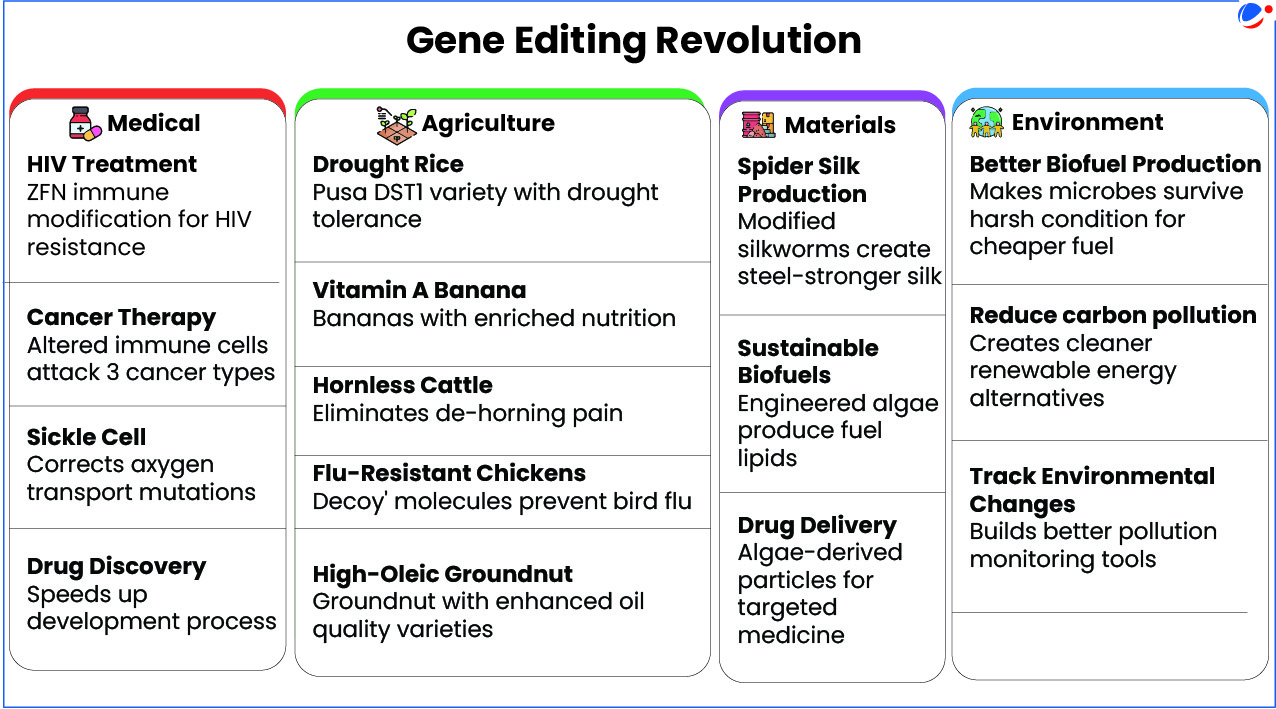Why in the News?
A research team from USA has developed and safely delivered a personalized gene editing therapy to treat an infant with a life-threatening, incurable genetic disease.
More on the News

- The infant was diagnosed with a genetic metabolic disorder called carbamoyl phosphate synthetase 1 (CPS-1) deficiency.
- CPS1 deficiency is characterized by an inability to fully break down byproducts from protein metabolism in the liver, causing ammonia to build up to toxic levels in the body.
- It can cause severe damage to the brain and liver. Treatment includes a low protein diet until the child is old enough for a liver transplant.
- The team of researchers customized a therapy using the gene-editing platform CRISPR, which allowed correction of a specific gene mutation in the baby's liver cells that led to the disorder.
About Gene Editing
- Gene editing is a technology that can change DNA sequences at one or more points in the strand.
- It also involves removing or changing a single base or insert a new gene altogether.
- The process involves three major steps that include insertion, deletion, and modification of the gene of interest.
Types of Gene Editing
- Somatic genome editing: It refers to the alteration of cells that cannot contribute to gamete formation and thus cannot be passed on from the individual to offspring.
- Targeted cells: Non-reproductive cells like skin, liver, kidney, muscle cells.
- Germline genome editing: Germline genome editing is genetic modification of reproductive cells or embryos that creates changes which can potentially be passed down to future generations.
- Targeted cells: Reproductive cells like Germ cells, embryos, or gamete-producing cells.
Techniques used for Gene Editing
Feature | ZFNs (Zinc Finger Nucleases) | TALENs (Transcription Activator-Like Effector Nucleases) | CRISPR-Cas9 |
Components | Zinc finger proteins (targeting) + FokI enzyme (cutting) | TALE proteins (targeting) + FokI enzyme (cutting) | Guiding RNA molecules + Cas9 enzyme (cutting) |
Function | Zinc finger proteins bind specific DNA sequences; FokI cuts DNA | TALE proteins bind specific DNA sequences; FokI cuts DNA | RNA guides Cas9 to cut specific DNA locations |
Purpose | Cuts DNA at precise locations | Cuts DNA at precise locations | Inserts, deletes, or modifies genes with high precision |
Origin | Zinc finger protein | TALE proteins from plant bacteria | Bacterial immune system against viruses |
Key Feature | First of the "genome editing" nucleases | Easier to design and program than ZFNs | Faster, cheaper, more accurate, easier to use |

Challenges Associated with Gene-Editing
Ethical Concerns
- Embryo Research Ethics: Many people hold deep moral or religious convictions that human embryos represent human life that deserves protection.
- From this perspective, using embryos for research purposes, which may involve manipulating, experimenting on, or ultimately destroying them is ethically problematic or even morally unacceptable.
- Informed Consent: There is debate about whether truly informed consent is possible for germline therapy, since the patients affected are embryos and future generations who cannot consent for themselves.
- Justice and Equity: Like many new technologies, there's concern that genome editing will only be accessible to wealthy individuals, potentially increasing healthcare disparities.
Safety concerns
- Safety Issues: The primary concern centers on off-target effects (edits occurring in unintended locations) and mosaicism (where only some cells carry the genetic edit while others don't).
- Due to these risks, researchers and ethicists generally agree that germline genome editing should not be used clinically for reproductive purposes until it's proven safe.
- Regulatory Inconsistency: Experts fear that varying global regulations on gene editing could lead to controversial uses like designer babies.
Conclusion
Gene editing technologies offer revolutionary potential to treat incurable genetic diseases, improve agriculture, and address environmental challenges. However, realizing this promise requires careful navigation of ethical concerns around safety, equity, and consent, particularly for germline editing that could affect future generations.




